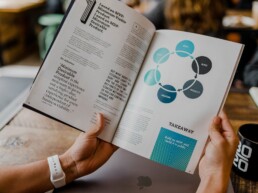A Simple Mobile App Design and Prototyping Process
Do you have a mobile app idea that has the potential to become a hit in the app marketplace? Are you looking to create an app that supports your customer base or your employees? Turning your app idea into a reality is a multiple-step prototyping process that requires a clear and organized plan. It is definitely a big challenge if you don’t have any experience with app design but if you have the desire to do it yourself, here are some steps to follow for designing and prototyping your first app.
First, start out with your app idea and write down how it will work in a simple way. Focus on what the goal of the app is, how it will help the user, and how to provide a great experience to the user. You also want to write down a list of features but you should save the complex features for later when you are making revisions. The idea here is to simplify the concept.

Second, begin your prototype. Simply use paper and pencil to create a rough draft of how your app will look like on a mobile device. Since it will consist of multiple screens, using index cards might be a good idea. Index cards work great because you can lay them out on a pin board and use strings to link screens that are connected for the next step.
Third, create a flow of your app. Organize all your index cards or pieces of paper so that you can make sense of how your app flows. Figure out which screens connect to each other and how all the screens will be laid out. This will include the main screen of your app to all the little features that lead to other screens in the app. The flow is pretty much the visualization of how your app will work.
Fourth, start to design the visuals of the app. Think about how link buttons will look, what kind of logo will be used, and which colors that will be used. You can also play around with the layout of your app to see what looks the most appealing. It’s a good idea to look at other apps for inspiration as this step may be the most difficult part of app design for non designers.

Finally, add in all your ideas for the app and optimize for UX and clean up the UI. Make sure your UI is organized, intuitive and useful. Go through all the screens of your app and start thinking about how you can improve the user experience whether it’s providing a relevant shortcut or making the buttons easier to click. From here, you want to keep revising until you feel like you have a great final product.
While you can design and prototype a mobile app yourself, there is still a big distinction between an amateur and an experienced designer. It’s a good idea to invest in a design firm to get involved in some way. Some business owners fear that their ideas and vision may be ignored.
However, the design and prototyping process can be a collaborative process if you work with the right design firm. An open minded firm can work with you so that your ideas make their way to the live version of your app. They’ll have experience with UX and UI design, so the firm will understand what elements build a successful app. While it can be a costly investment, hiring a design firm is far cheaper than launching an app that fails due to its design flaws.
Next Item
Baby Steps: Identifying Your Brand

Revolutionizing UX Design with the Binary Approach to Project Management
Embracing a clear approach to task completion—where tasks are strictly marked as 'done' or 'not done'—can significantly enhance the efficiency, clarity, and accountability of UX projects. This project management method offers a straightforward…
Human-Centered Design: The Heart of Creating Impactful Digital and Physical Experiences
Whether it be digital, physical, or conceptual, one philosophy consistently emerges as the cornerstone of impactful and effective creation: Human-Centered Design (HCD). At its core, Human-centered design isn’t just a methodology; it’s a…
The Conundrum of Empathy in UX Design: A Driving Force or an Unrealistic Ideal?
Empathy is often touted as the backbone of user experience (UX) design, a tool to perceive and feel what end users might experience. However, the practicality and efficacy of empathy in UX design is a subject of intense debate. While empathy can be…


